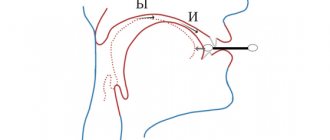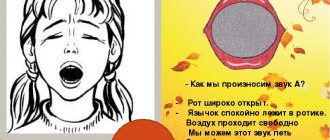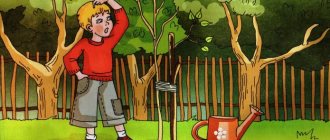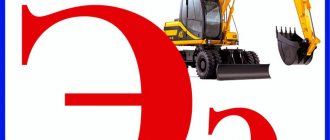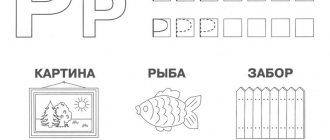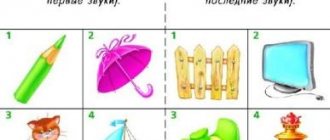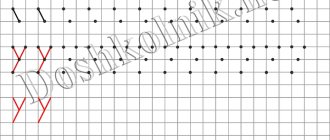Introducing the letter Y
It is easiest to explain to a child what this letter looks like using pictures . A visual sequence is created from the words: tea, iodine, parrot, yogurt, yogi. All words are spoken loudly with the children. You need to pay attention to the overall sound through intonation. The guys must guess whether Y is located at the beginning or at the end of the word.
The next stage is a separate pronunciation of Y. At the same time, the teacher explains how the speech apparatus should work: the tip of the tongue is hidden behind the lower teeth, and the back of the tongue rises up and does not allow air to escape from the mouth.
What children should know about the sound Y:
- is it vowel or consonant;
- voiced or voiceless;
- long or short.
Looking at the image of Y, the children guess what other letter it is similar to and find out how they differ:
- Look, I and Y are almost the same, but the sounds are different: I is a vowel, and Y is a consonant.
The material is reinforced with new examples: seagull, Aibolit, tram, beautiful, bunny, kind, hero, red. Words are sorted by syllables.
Learning to read and write “Sounds [i], [th] and letters I, J”
Let's start our Internet lesson with a fairy tale...
“One boy drew a forest animal with long ears, large hind legs and a small tail. And he wrote down the name of the animal so that no one would doubt it. This is where the miracles began... The animal suddenly spoke!...
-Be - be - disgrace! - he said.
-Why is it disgraceful? -Ko – ko – of course! - the animal got angry. The boy was surprised: -What's the matter? Now you're bleating like a sheep, now you're clucking like a chicken... - Moo-moo-moo - you're a reader, that's who! - the animal hummed. - What did you do to me? -Nothing. Did I draw you poorly? -No, you can find out. -So what's the deal? -Z – why did you make me for – for – stuttering? I'm not a stutterer.
The boy caught himself and drew another tail, but this time to the letter I. And the animal stopped stuttering. “Thank you,” he said. – Now everyone knows that I am….
- Can you guess who the boy drew? What letters did the boy mix up?
So today we will get acquainted with these sounds and letters. The sounds are different. Compare: needle and yogurt.
What is the first sound in the word “needle”? What sound is this?... Yes, the sound [and] is a vowel sound
What is the first sound in the word "yogurt"? What are the features of the sound [th'] ? (consonant, soft, voiced).
Remember! The sound [th'] is ALWAYS SOFT and sonorous!
1. Think of words with the sound [th'] at the beginning (iod, yogi, iota), in the middle (t-shirt, watering can, snake), at the end of the word (may, tea, edge).
2. Change the words so that they denote a request, an order, an incentive to action: stands (stand), washes (my), builds (build), sings (sing), decides (decide), plays (play), repeats (repeat ), floats (swim), thinks (think).
3. Listen to the words , say where and in what position the sound [th'] : strong, jockey, puck, iodine, ruler.
4. Clap your hands once if you hear the sound [th'] in the words: fox, husky, player, face, washbasin, nightingale, bus, trolleybus, scissors, car, snake, name, tea.
How strange, the sounds are different, but the letters are almost written very, very similar. Don't get confused! It is very important to read words correctly; replacing one letter will change the meaning of the word. So that the bunny doesn't turn into a bunny ...
5. Say the word
The house on rails is right here,
He will kill everyone in five minutes. Sit down and don't yawn. Departs... (tram).
***
The doctor lives in a glass jar. He treats sores and wounds. “Oh, how it stings!”, “Oh, how it burns!” Do you recognize? This is... (iodine)
In winter the mosquitoes have fallen asleep, the bear is sleeping in its den, and somewhere in the jungle they are languishing from the heat... (yogis)
***
Guess what we sang? “Kara...” (wai). Guess what they sang to us? “Bai...” (bye). What month is it, guess?
The month of May). What's in the glass, guess? Sweet... (tea) Meet the letter I and the letter Y !
1. Look carefully at the letters, find similarities and differences.
2. Find the hidden letters I and Y. Circle them.
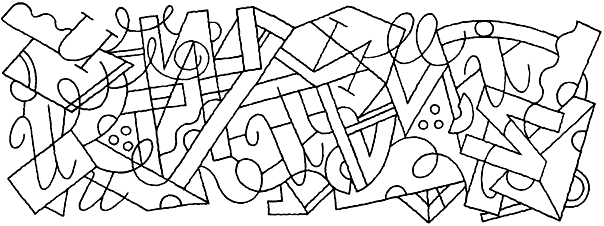
3. Identify the letter in the wrong position.
4. Repair the letters:
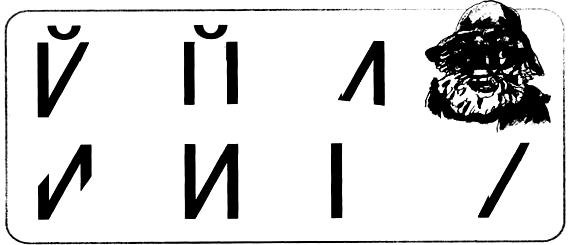
5. Highlight a familiar letter.

6. Color only those cubes on which the letter Y .
7. Color both letters I in red on the right side of the picture. Shade the letter according to the pattern in the middle of the picture. Find and color the letter I on the right side of the picture.

8. Color both letters green. Shade it. Find and color the letter Y.
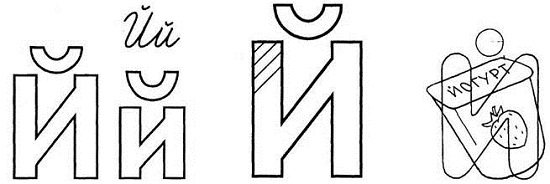
9 . Connect with the letter And only those objects whose names begin with the sound [and] .
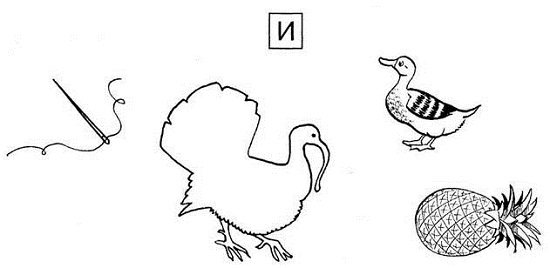
10 . Connect with the letter Y only those objects whose names begin with the sound [th'] .
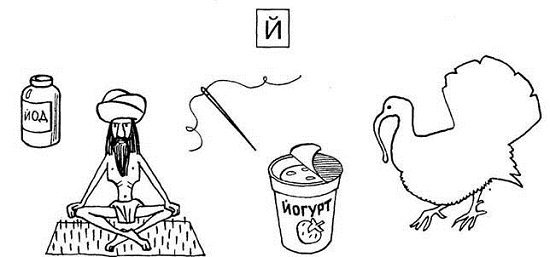
11. Underline the same letter as below in the picture on the left. Circle all the letters I in the picture on the right.
12.
Letter Y
The name is “And short”
and
like I in your notebook.
So as Y
with I, write a tick at the top.
Take a green pencil and color in all the parts of the drawing in which you see the letters Y.
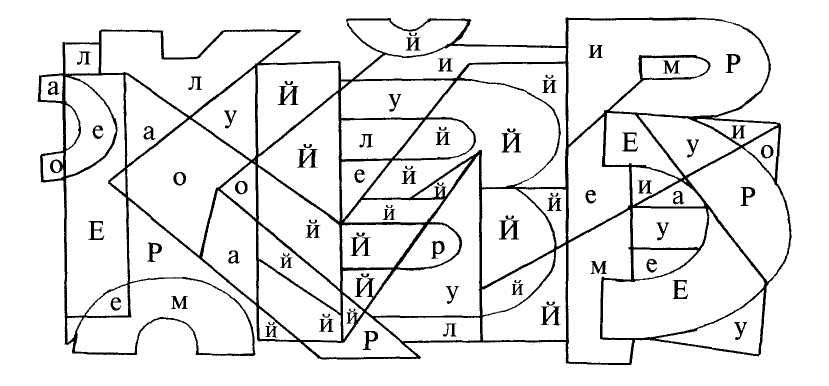
13. We are writing...
Learn to write beautifully here

14.
Dictionary
- Illusion - fiction, fantasy
- Illusionist - magician
- Image - the “image” of a product, service, enterprise, person
- Immunity is the body's defense reaction
- An empire is a powerful power that unites different peoples and territories into a single state
- Intelligence - mind
- Hippodrome is a sports complex for equestrian competitions.
- Research is an action in which scientists study a phenomenon.
- Iodine is a chemical element.
- Yoga is a physical exercise to keep fit. This is a special lifestyle and way of thinking.
Catchphrases or phraseological units
- To play the first violin is to play a leading role in any matter; to be a leader, a ringleader.
- Playing with fire means taking risks.
- To follow in someone's footsteps is to imitate someone; follow someone's example.
- Going against the grain - doing something contrary to those around you.
- To pour out your soul is to tell someone about something most intimate and personal.
- Looking for a needle in a haystack means looking among a large volume; to look for something that is obviously impossible to find.
- Sparks flew from the eyes - indicating the consequences of a strong blow.
I recommend reading:
- 77 Effective Educational Techniques
- Interesting...Great people who changed the world
- Holiday "Farewell, ABC!" (scenario)
- Online lesson on literary reading “M. Lermontov "Borodino"
Tags: Online Russian language reading
Setting the sound Y
Before starting the exercises, it is necessary to correctly establish articulation: arch the tongue so that its tip rests with tension on the lower teeth. The upper part, in contact with the sky, should also be hard. The child will feel a compressed stream of air when pronouncing the sound Y. Then you need to ease the tension of the tongue and remove the arch.
To make the activity fun, ask the children to show how the cat gets angry and arches its back using its tongue.
Several more articulation training sessions contribute to correct speech production.
- Spatula. Open your mouth, exposing your teeth, place a tense tongue in the form of a spatula on the lower row of teeth so that the edges of the tongue touch the corners of the mouth.
- Smile. Smile several times with your lips closed and open.
- Let's punish the naughty tongue. Place your tongue on your lower lip and lightly bite it with your upper teeth with the sound “ta-ta-ta,” then slap your lips with the sound “five-five-five.”
Basic methods
In addition to directly pronouncing the sound Y, there are two auxiliary methods:
- Imitation:
- rapid pronunciation of the sound I with A, O, U followed by yotation (ia-ya, io-yo, iu-yu);
- transition from soft unvoiced to voiced.
- Mechanical impact. Apply with a spatula in difficult cases. When pronouncing the sound “zya,” the speech therapist presses on the tip of the tongue and moves it slightly deeper until the sound “ya” is produced.
Lesson summary:
- Pronunciation of new words increases the preschooler’s vocabulary, develops speech and memory.
- Cell exercises develop fine motor skills of the hands.
- Riddles develop children's intelligence, ability to analyze and prove. Teachers use riddles when teaching children to increase interest during complex tasks.
- Poems influence not only the development of memory. It has been proven that if you learn a few lines every day, new neural connections appear in the brain and your overall learning ability increases.
Task for preschoolers: printed letter Y
After a visual demonstration, you can begin to study the letter on paper . Before this, children will happily repeat after an adult how to write Y in the air, and then try to perform the action with a simple pencil or pen.
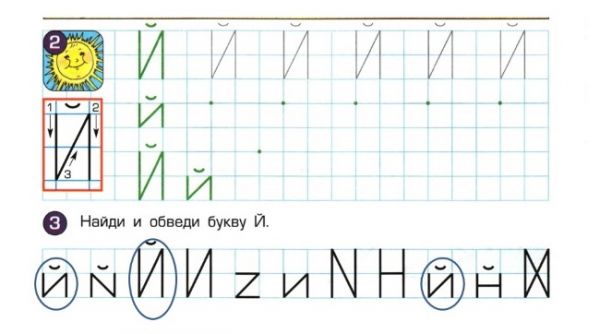
Copying the printed letter y.
For convenience, it is better to use a checkered notebook sheet. You need to start with the elements: first show how to draw two vertical lines, then a diagonal line and an upper bow. When the child completes these tasks, he will easily cope with the entire letter. If difficulties arise, ask him to draw lines along the reference points or dotted lines.
Children are just beginning to learn the alphabet, so don't insist on spelling.
Riddles for children starting with the letter J
When it boils, steam comes out, and it whistles and bursts with heat, the lid rattles and knocks. - Hey, take me off! - shouts. (Kettle)
Amazing carriage! Judge for yourself: The rails are in the air, and he holds them with his hands. (Trolleybus)
In a woolen clearing, a thin-legged animal dances. A stitch creeps out from under a steel shoe. (Sewing machine)
It might break. It can be boiled, If you want, it can turn into a bird. (Egg) Tell me, who is so afraid of things, Like a dog is afraid of a stick, Like a bird is afraid of a stone? (Lazy person)
I run to my mother river and cannot remain silent. I am her own son, and was born in the spring. (Creek)
He produces sheets of Wide Latitude. Supported by strong stems One hundred rough, tenacious fruits: If you don’t get around them, you’ll find them all on yourself. (burdock)
He grew up in a field angry and prickly, There were needles in all directions. (burdock)
I am always friendly with the light. If the sun is in the window, I run along the wall from the mirror, from the puddle. (Sunny bunny)
There is a button on the head, a sieve in the nose, one hand, and even that on the back. (Kettle)
Tales about the letter
Preschool children perceive many concepts and phenomena through fairy tales. Letters and sounds are no exception; they play different fairy-tale roles and themselves become bright and memorable characters.
A fairy tale about a mouse - yoga.
One day a mouse was walking in the garden and found a book there. “Who are yogis,” he read, and then looked at his uncle on the cover. He sat down with his eyes closed on a board covered with sharp nails. The mouse opened the book and saw the same guy standing on hot coals and sitting in a block of ice.
“Oh yes yogi!” - exclaimed the mouse. - “I want to try this too. I can imagine how surprised my mother will be when she sees me in the refrigerator!”
The animal decided to start with nails, but as soon as it tried to lie down on a prickly board, it shouted to the whole garden: “Oh, Oeeeeee!”
The mouse ran home, found iodine and began to smear it on his scratches. And iodine burns. The mouse oohed and oohed, and then thought: “I’ll throw this book to the cat, let him be a yogi now!”
A fairy tale about sisters I and J.
One day I and J went to a cafe after a walk. The waiter approached them and asked:
— What will you order?
The letter Y answered clearly and quickly:
- Please, seaweed salad - there is a lot of iodine, tea and puff pastry with cherries. All.
I started ordering here:
- And I want carrot salad with raisins and cabbage salad, and Olivier salad, and... and...
Poor And could not stop and kept talking and saying:
- And ice cream sundae, and with jam, and with condensed milk, and with strawberries...
The waiter stopped writing down and looked at I in surprise. Then sister Y guessed, took off her hat and put it on I, she became short and was able to stop.
For a long time they ate everything that was brought to them. Since then, Yi has not gone to a cafe alone, because only her sister Y can separate everything (may-ka, layer-ka) and complete it, so she can more often be found at the end of a word - give, bark, than at the beginning - iodine, yogurt .
Funny poems about the letter J for children
Iodine is good, iodine is not evil. In vain you shout: “Oh-oh-oh!” — I just saw a bottle of iodine. Iodine sometimes burns, of course, but a wound smeared with iodine will heal faster. (V. Lunin)
Play, bunny, play with me. The bunny answers: “I can’t, I’m sick!” Oh-oh-oh, poor thing! (E. Blaginina)
Oh-oh-oh! - said OH-OH. - I, my friend, am completely sick! - Go for a walk! All will pass! - said AY-AY. (G. Vieru)
A yogi will never say: “Oh!” "Oh oh oh!" - the yogi will not shout. Young man, control yourself! Old, be like young! (V. Berestov)
I am on the tails of birds and animals: Here is an ermine, here is a sparrow. (E. Grigorieva)
At the “I Brief” station We were greeted with a riddle: “Read, dare and guess - How, without getting up from your seat, can you turn a tram into many trams? ...What should you skip so that you can turn a bunny into a stutterer?” One of us thought about the answer for about three minutes and answered, “Erase the hook above the letter “And short.” (S. Marshak)
The ant found a blade of grass and had a lot of trouble with it. He carries it home like a log on his back... He bends under the burden. He is already crawling with difficulty. But what a good house the Ants are building! (3. Alexandrova)
Suitable games for children
Namely:
- We learn letters and clap our hands: clap once when the sound Y appears: fox, name, husky, toffee, car, wash, strength, parrot, crocodile, husky.
- My, my, mine: my sparrow - my sparrows, my tram - my trams, my nightingale - my nightingales, my T-shirt - my T-shirts.
- Ask to do something depending on the verb: sing - sing, play - play, dance - dance, etc.
In a playful way, it is easier for children to master the pronunciation of complex sounds and remember the rules for their use.
